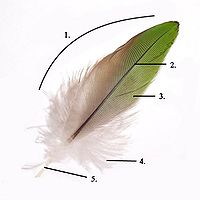Origin of birds
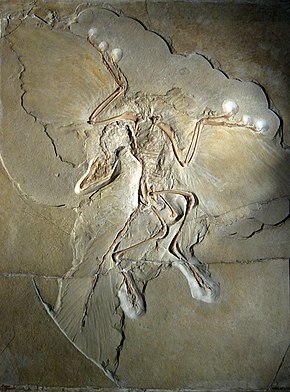
The scientific question of within which larger group of animals birds evolved has traditionally been called the "origin of birds". The present scientific consensus is that birds are a group of maniraptoran theropod dinosaurs that originated during the Mesozoic Era.
A close relationship between birds and dinosaurs was first proposed in the nineteenth century after the discovery of the primitive bird
Although the origin of birds has historically been a contentious topic within evolutionary biology, only a few scientists still dispute the dinosaurian origin of birds, suggesting descent from other types of archosaurian reptiles. Within the consensus that supports dinosaurian ancestry, the exact sequence of evolutionary events that gave rise to the early birds within maniraptoran theropods is disputed. The origin of bird flight is a separate but related question for which there are also several proposed answers.
Research history
Huxley, Archaeopteryx and early research
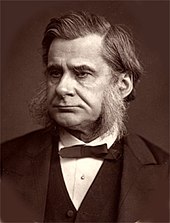
Scientific investigation into the origin of birds began shortly after the 1859 publication of
Biologist Thomas Henry Huxley, known as "Darwin's Bulldog" for his tenacious support of the new theory of evolution by means of natural selection, almost immediately seized upon Archaeopteryx as a transitional fossil between birds and reptiles. Starting in 1868, and following earlier suggestions by Carl Gegenbaur,[6] and Edward Drinker Cope,[7] Huxley made detailed comparisons of Archaeopteryx with various prehistoric reptiles and found that it was most similar to dinosaurs like Hypsilophodon and Compsognathus.[8][9] The discovery in the late 1870s of the iconic "Berlin specimen" of Archaeopteryx, complete with a set of reptilian teeth, provided further evidence. Like Cope, Huxley proposed an evolutionary relationship between birds and dinosaurs. Although Huxley was opposed by the very influential Owen, his conclusions were accepted by many biologists, including Baron Franz Nopcsa,[10] while others, notably Harry Seeley,[11] argued that the similarities were due to convergent evolution.
Heilmann and the thecodont hypothesis
A turning point came in the early twentieth century with the writings of
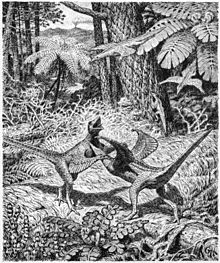
Like Huxley, Heilmann compared Archaeopteryx and other birds to an exhaustive list of prehistoric reptiles, and also came to the conclusion that theropod dinosaurs like Compsognathus were the most similar. However, Heilmann noted that birds had
Clavicles are relatively delicate bones and therefore in danger of being destroyed or at least damaged beyond recognition. Nevertheless, some fossil theropod clavicles had actually been excavated before Heilmann wrote his book, but these had been misidentified.[16] The absence of clavicles in dinosaurs became the orthodox view despite the discovery of clavicles in the primitive theropod Segisaurus in 1936.[17] The next report of clavicles in a dinosaur was in a Russian article in 1983.[18]
Contrary to what Heilmann believed, paleontologists now accept that clavicles and in most cases furculae are a standard feature not just of theropods but of saurischian dinosaurs. Up to late 2007 ossified furculae (i.e. made of bone rather than cartilage) have been found in all types of theropods except the most basal ones, Eoraptor and Herrerasaurus.[19] The original report of a furcula in the primitive theropod Segisaurus (1936) was confirmed by a re-examination in 2005.[20] Joined, furcula-like clavicles have also been found in Massospondylus, an Early Jurassic sauropodomorph.[21]
Ostrom, Deinonychus, and the dinosaur renaissance

The tide began to turn against the 'thecodont' hypothesis after the 1964 discovery of a new theropod dinosaur in Montana. In 1969, this dinosaur was described and named Deinonychus by John Ostrom of Yale University.[22] The next year, Ostrom redescribed a specimen of Pterodactylus in the Dutch Teylers Museum as another skeleton of Archaeopteryx.[23] The specimen consisted mainly of a single wing and its description made Ostrom aware of the similarities between the wrists of Archaeopteryx and Deinonychus.[24]
In 1972, British paleontologist Alick Walker hypothesized that birds arose not from 'thecodonts' but from crocodile ancestors like Sphenosuchus.[25] Ostrom's work with both theropods and early birds led him to respond with a series of publications in the mid-1970s in which he laid out the many similarities between birds and theropod dinosaurs, resurrecting the ideas first put forth by Huxley over a century before.[26][27][28] Ostrom's recognition of the dinosaurian ancestry of birds, along with other new ideas about dinosaur metabolism,[29] activity levels, and parental care,[30] began what is known as the dinosaur renaissance, which began in the 1960s and, according to some, continues to this day.[31]
Ostrom's revelations also coincided with the increasing adoption of phylogenetic systematics (cladistics), which began in the 1960s with the work of Willi Hennig.[32] Cladistics is an exact method of arranging species based strictly on their evolutionary relationships, which are calculated by determining the evolutionary tree implying the least number of changes in their anatomical characteristics. In the 1980s, cladistic methodology was applied to dinosaur phylogeny for the first time by Jacques Gauthier and others, showing unequivocally that birds were a derived group of theropod dinosaurs.[33] Early analyses suggested that dromaeosaurid theropods like Deinonychus were particularly closely related to birds, a result that has been corroborated many times since.[34][35]
Feathered dinosaurs in China

The early 1990s saw the discovery of spectacularly preserved bird fossils in several
Digit homology
There is a debate between
Embryologists and some paleontologists who oppose the bird-dinosaur link have long numbered the digits of birds II-III-IV on the basis of multiple studies of the development in the egg.[48] This is based on the fact that in most amniotes, the first digit to form in a 5-fingered hand is digit IV, which develops a primary axis. Therefore, embryologists have identified the primary axis in birds as digit IV, and the surviving digits as II-III-IV. The fossils of advanced theropod (Tetanurae) hands appear to have the digits I-II-III (some genera within Avetheropoda also have a reduced digit IV[49]). If this is true, then the II-III-IV development of digits in birds is an indication against theropod (dinosaur) ancestry. However, with no ontogenical (developmental) basis to definitively state which digits are which on a theropod hand (because no non-avian theropods can be observed growing and developing today), the labelling of the theropod hand is not absolutely conclusive.[citation needed]
Paleontologists have traditionally identified avian digits as I-II-III. They argue that the digits of birds number I-II-III, just as those of theropod dinosaurs do, by the conserved phalangeal formula. The phalangeal count for archosaurs is 2-3-4-5-3; many archosaur lineages have a reduced number of digits, but have the same
A small minority, known by the acronym BAND (Birds Are Not Dinosaurs),
An alternative to the frame-shift hypothesis is the axis-shift. According to this explanation, the primary limb axis in birds runs through digit III instead of IV.[48][59] This idea is supported by palaeontological observations, which determine the phalangeal formula 2-3-4-1-X for the last common ancestor of ceratosaurs (including Limusaurus) and tetanurans (including the tridactyl forms with the phalangeal formula 2-3-4-X-X).[60]
Some later embryological data support the identification of bird digits as I, II, III as in their theropod ancestors.[61]
Thermogenic muscle hypothesis
A 2011 publication suggested that selection for the expansion of
Phylogeny
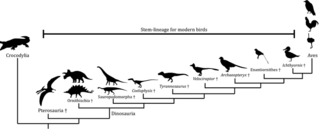
Archaeopteryx has historically been considered the first bird, or Urvogel. Although newer fossil discoveries filled the gap between theropods and Archaeopteryx, as well as the gap between Archaeopteryx and modern birds,
Other studies have proposed alternative phylogenies, in which certain groups of dinosaurs usually considered non-avian may have evolved from avian ancestors. For example, a 2002 analysis found that oviraptorosaurs were basal avians.[70] Alvarezsaurids, known from Asia and the Americas, have been variously classified as basal maniraptorans,[34][35][71][72] paravians,[68] the sister taxon of ornithomimosaurs,[73] as well as specialized early birds.[74][75] The genus Rahonavis, originally described as an early bird,[76] has been identified as a non-avian dromaeosaurid in several studies.[69][77] Dromaeosaurids and troodontids themselves have also been suggested to lie within Aves rather than just outside it.[78][79]
Features linking birds and dinosaurs
Many anatomical[80] features are shared by birds and other theropod dinosaurs.
Feathers
Since the 1990s, a number of additional
A small minority of researchers have claimed that the simple filamentous "protofeather" structures are simply the result of the decomposition of collagen fiber under the dinosaurs' skin or in fins along their backs, and that species with unquestionable feathers, such as oviraptorosaurs and dromaeosaurs are not dinosaurs, but true birds unrelated to dinosaurs.[83] However, a majority of studies have concluded that feathered dinosaurs are in fact dinosaurs, and that the simpler filaments of unquestionable theropods represent simple feathers. Some researchers have demonstrated the presence of color-bearing melanin in the structures—which would be expected in feathers but not collagen fibers.[84] Others have demonstrated, using studies of modern bird decomposition, that even advanced feathers appear filamentous when subjected to the crushing forces experienced during fossilization, and that the supposed "protofeathers" may have been more complex than previously thought.[85] Detailed examination of the "protofeathers" of Sinosauropteryx prima showed that individual feathers consisted of a central quill (rachis) with thinner barbs branching off from it, similar to but more primitive in structure than modern bird feathers.[86]
The 2022 description of branched feathers in the pterosaur Tupandactylus provides strong evidence that "pycnofibers" are not actually a distinct integument unrelated to origin of feathers. The most parsimonious scenario is the presence of feathers in the last common ancestor of pterosaurs and dinosaurs already in the Early Triassic. Tupandactylus's melanosomes indicate visual signalling was an important factor in the evolution of feathers.[87]
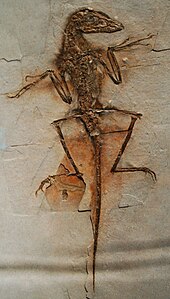
Skeleton
Because feathers are often associated with birds, feathered dinosaurs are often touted as the "missing link" between birds and other dinosaurs. However, the multiple skeletal features also shared by the two groups represent the more important proof for paleontologists.
Comparisons of bird and dinosaur skeletons, as well as
A study comparing embryonic, juvenile and adult archosaur skulls concluded that bird skulls are derived from those of
Lungs

Large meat-eating dinosaurs had a complex system of air sacs similar to those found in modern birds, according to an investigation led by Patrick M. O'Connor of Ohio University. In theropod dinosaurs (carnivores that walked on two legs and had birdlike feet) flexible soft tissue air sacs likely pumped air through the stiff lungs, as is the case in birds. "What was once formally considered unique to birds was present in some form in the ancestors of birds", O'Connor said.[90][91]
Heart
A study published in 2011 applied multiple lines of inquiry to the question of the object's identity, including more advanced CT scanning,
The question of how this find reflects metabolic rate and dinosaur internal anatomy is moot, though, regardless of the object's identity.[95] Both modern crocodilians and birds, the closest living relatives of dinosaurs, have four-chambered hearts (albeit modified in crocodilians), so dinosaurs probably had them as well; the structure is not necessarily tied to metabolic rate.[96]
Sleeping posture
Fossils of the
Reproductive biology
When laying eggs, female birds grow a special type of bone in their limbs. This
Brooding and care of young
Several
Numerous dinosaur species, for example Maiasaura, have been found in herds mixing both very young and adult individuals, suggesting rich interactions between them.
A dinosaur embryo was found without teeth, which suggests some parental care was required to feed the young dinosaur, possibly the adult dinosaur regurgitated food into the young dinosaur's mouth (see
Gizzard stones
Both birds and dinosaurs use gizzard stones. These stones are swallowed by animals to aid digestion and break down food and hard fibres once they enter the stomach. When found in association with fossils, gizzard stones are called gastroliths.[101] Gizzard stones are also found in some fish (mullets, mud shad, and the gillaroo, a type of trout) and in crocodiles.
Molecular evidence
On several occasions, the extraction of DNA and proteins from Mesozoic dinosaurs fossils has been claimed, allowing for a comparison with birds. Several proteins have putatively been detected in dinosaur fossils,[102] including hemoglobin.[103] In 2023, beta-protein structures were reported from the feathers of the dinosaur Sinornithosaurus and the early bird Confuciusornis.[104] This confirms that ancient feathers had a composition similar to that of modern birds. Some fossil feathers were reported to have a composition rich in alpha proteins, but fossilization experiments demonstrate that this protein composition is simply an artefact of preservation, because beta-sheet protein structures are readily transformed to alpha-helices during thermal maturation.[104]
In the March 2005 issue of
The successful extraction of ancient DNA from dinosaur fossils has been reported on two separate occasions, but upon further inspection and peer review, neither of these reports could be confirmed.[114]
Origin of bird flight
Debates about the origin of bird flight are almost as old as the idea that birds evolved from dinosaurs, which arose soon after the discovery of Archaeopteryx in 1862. Two theories have dominated most of the discussion since then: the cursorial ("from the ground up") theory proposes that birds evolved from small, fast predators that ran on the ground; the arboreal ("from the trees down") theory proposes that powered flight evolved from unpowered gliding by arboreal (tree-climbing) animals. A more recent theory, "wing-assisted incline running" (WAIR), is a variant of the cursorial theory and proposes that wings developed their aerodynamic functions as a result of the need to run quickly up very steep slopes such as trees, which would help small feathered dinosaurs escape from predators.
In March 2018, scientists reported that
Cursorial ("from the ground up") theory
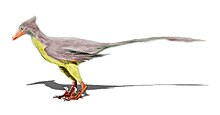
The cursorial theory of the origin of flight was first proposed by Samuel Wendell Williston, and elaborated upon by Baron Nopcsa. This hypothesis proposes that some fast-running animals with long tails used their arms to keep their balance while running. Modern versions of this theory differ in many details from the Williston-Nopcsa version, mainly as a result of discoveries since Nopcsa's time.
Nopcsa theorized that increasing the surface area of the outstretched arms could have helped small cursorial predators keep their balance, and that the scales of the forearms elongated, evolving into feathers. The feathers could also have been used to trap insects or other prey. Progressively, the animals leapt for longer distances, helped by their evolving wings. Nopcsa also proposed three stages in the evolution of flight. First, animals developed passive flight, in which developing wing structures served as a sort of parachute. Second, they achieved active flight by flapping the wings. He used Archaeopteryx as an example of this second stage. Finally, birds gained the ability to soar.[117]

While some authors had rejected the homology between feathers and scales due to their different proteins,[118] recent studies provide evidence that those structures do share a common origin.[119][120] However, Nopcsa's theory assumes that feathers evolved as part of the evolution of flight, and recent discoveries show that feathers evolved millions of years before flight.[119][87]
All of the Archaeopteryx fossils come from marine sediments, and it has been suggested that wings may have helped the birds run over water in the manner of the Jesus Christ Lizard (common basilisk).[129]
Most recent opposition to the "from the ground up" hypothesis attempt to refute the modern version's assumption that birds are modified coelurosaurian dinosaurs. The criticism is based on
Fowler et al. (2011) proposed a model explaining how dromaeosaurids may have hunted. The animal would use its wing as stabilizers while standing on top of its prey eating it alive in the manner of an eagle or a hawk. The authors consider this an important addition to the topic of how flapping movements evolved, arguing they likely precede flight.[132]
Wing-assisted incline running
The
Arboreal ("from the trees down") theory

Most versions of the arboreal hypothesis state that the ancestors of birds were very small dinosaurs that lived in trees, springing from branch to branch. This small dinosaur already had feathers, which were co-opted by evolution to produce longer, stiffer forms that were useful in aerodynamics, eventually producing wings. Wings would have then evolved and become increasingly refined as devices to give the leaper more control, to parachute, to glide, and to fly in stepwise fashion. The arboreal hypothesis also notes that, for arboreal animals, aerodynamics are far more energy efficient, since such animals simply fall to achieve minimum gliding speeds.[138][139]
Several small dinosaurs from the Jurassic or Early Cretaceous, all with feathers, have been interpreted as possibly having arboreal and/or aerodynamic adaptations. These include Scansoriopteryx, Epidexipteryx, Microraptor, Pedopenna, and Anchiornis. Anchiornis is particularly important to this subject, as it lived at the beginning of the Late Jurassic, long before Archaeopteryx.[140]
Analysis of the proportions of the toe bones of the most primitive birds Archaeopteryx and Confuciusornis, compared to those of living species, suggest that the early species may have lived both on the ground and in trees.[141]
One study suggested that the earliest birds and their immediate ancestors did not climb trees. This study determined that the amount of toe claw curvature of early birds was more like that seen in modern ground-foraging birds than in perching birds.[142]
Diminished significance of Archaeopteryx
Archaeopteryx was the first and for a long time the only known feathered Mesozoic animal. As a result, discussion of the evolution of birds and of bird flight centered on Archaeopteryx at least until the mid-1990s.
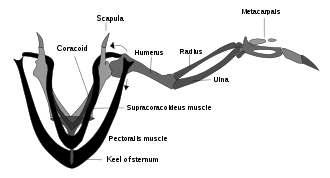
There has been debate about whether Archaeopteryx could really fly. It appears that Archaeopteryx had the brain structures and inner-ear balance sensors that birds use to control their flight.[143] Archaeopteryx also had a wing feather arrangement like that of modern birds and similarly asymmetrical flight feathers on its wings and tail. But Archaeopteryx lacked the shoulder mechanism by which modern birds' wings produce swift, powerful upstrokes (see diagram above of supracoracoideus pulley); this may mean that it and other early birds were incapable of flapping flight and could only glide.[136]
But the discovery since the early 1990s of many
Secondary flightlessness in dinosaurs
| Coelurosaurs |
| ||||||||||||||||||||||||||||||||||||||||||||||||||||||||||||
Groups usually regarded as birds are in bold type.[79]
A minority hypothesis, credited to the books Predatory Dinosaurs of the World (1988) and Dinosaurs of the Air (2002) by scientific illustrator
Mayr et al. (2005) analyzed a new, tenth specimen of Archaeopteryx, and concluded that Archaeopteryx was the sister clade to the Deinonychosauria, but that the more advanced bird Confuciusornis was within the Dromaeosauridae.[152] This paper, however, excluded all other birds and thus did not sample their character distributions. The paper was criticized by Corfe and Butler (2006) who found the authors could not support their conclusions statistically. Mayr et al. agreed that the statistical support for the authors' earlier paper was weak but stated that it is also weak for the alternative scenarios.[153]
Most subsequent
In Euornithes, the earliest unequivocal example of secondary flightlessness is Patagopteryx.[156]
See also
- Bird ichnology
- Dinosaur Discovery Museum
- Evolution of birds
- Feathered dinosaurs
- Flightless birds
- List of extinct birds
- Origin of avian flight
- Temporal paradox (paleontology)
Footnotes
- .
- ^ S2CID 205049989.
- ISBN 978-1-4353-9386-8.
- ^ von Meyer, C.E. Hermann. (1861). "Archaeopteryx lithographica (Vogel-Feder) und Pterodactylus von Solnhofen". Neues Jahrbuch für Mineralogie, Geologie und Paläontologie (in German). 1861: 678–679.
- .
- ^ Gegenbaur, C. (1863). "Vergleichend-anatomische Bemerkungen über das Fußskelet der Vögel". Archiv für Anatomie, Physiologie und Wissenschaftliche Medicin. 1863: 450–472.
- ^ Cope, E.D. (1867). "An account of the extinct reptiles which approached the birds". Proceedings of the Academy of Natural Sciences of Philadelphia. 19: 234–235.link
- ^ Huxley, T.H. (1868). "On the animals which are most nearly intermediate between birds and reptiles". Annals and Magazine of Natural History. 4th. 2: 66–75.
- doi:10.1144/GSL.JGS.1870.026.01-02.08 – via Wikisource.
- .
- ^ Seeley, Harry G. (1901). Dragons of the Air: An Account of Extinct Flying Reptiles. London: Methuen & Co. p. 239pp.
- ^ Abel, O (1911). "Die Vorfahren der Vögel und ihre Lebensweise". Verhandlungen der Zoologisch-Botanischen Gesellschaft in Wien. 61: 144–191.
- ^ Nieuwland, Ilja J.J. (2004). "Gerhard Heilmann and the artist's eye in science, 1912-1927" (PDF). PalArch's Journal of Vertebrate Palaeontology. 3 (2). Archived from the original (PDF) on 2016-02-24. Retrieved 2009-05-21.
- ISBN 978-0-486-22784-9.
- ^ ISBN 978-0-520-24209-8.
- ISBN 978-0-8018-6763-7.
- ^ Camp, Charles L. (1936). "A new type of small theropod dinosaur from the Navajo Sandstone of Arizona". Bulletin of the University of California Department of Geological Sciences. 24: 39–65.
- ^ In an Oviraptor: Barsbold, R. (1983). "Carnivorous dinosaurs from the Cretaceous of Mongolia". Trudy Soumestnaya Sovetsko-Mongol'skaya Paleontogicheskaya Ekspeditsiya (in Russian). 19: 1–117. See the summary and pictures at "A wish for Coelophysis". Archived from the original on February 3, 2008.
- S2CID 86234363.on 2011-05-22. Retrieved 2008-04-17. This lists a large number of theropods in which furculae have been found, as well as describing those of Suchomimus Tenerensis and Tyrannosaurus rex.
{{cite journal}}: CS1 maint: multiple names: authors list (link) - full text currently online at "The Furcula in Suchomimus Tenerensis and Tyrannosaurus rex". 2007-11-11. Archived from the original - S2CID 30039789. Archived from the original (PDF) on 2006-05-12.)
{{cite journal}}: CS1 maint: multiple names: authors list (link - S2CID 85679726.
- ^ Ostrom, John H. (1969). "Osteology of Deinonychus antirrhopus, an unusual theropod from the Lower Cretaceous of Montana". Bulletin of the Peabody Museum of Natural History. 30: 1–165.
- S2CID 46682559.
- ISBN 978-0-7195-6054-5.
- S2CID 4174690.
- S2CID 29873831.
- ISBN 978-0-912532-57-8.
- .
- S2CID 4176132.
- S2CID 4370793.
- ^ Darren Naish, 2021, "Dinosaur Renaissance", in Dinopedia - A Brief Compendium of Dinosaur Lore, Princeton University Press
- ISBN 978-0-252-06814-0.
- ^ a b Gauthier, Jacques. (1986). "Saurischian monophyly and the origin of birds". In Padian, Kevin (ed.). The Origin of Birds and the Evolution of Flight. Memoirs of the California Academy of Sciences 8. pp. 1–55.
- ^ S2CID 83726237.
- ^ S2CID 31096081.
- S2CID 41106677.
- S2CID 4357707.)
{{cite journal}}: CS1 maint: multiple names: authors list (link - ^ Ji Qiang; Ji Shu-an (1996). "On the discovery of the earliest bird fossil in China and the origin of birds" (PDF). Chinese Geology. 233: 30–33.
- S2CID 4430927.)
{{cite journal}}: CS1 maint: multiple names: authors list (link - PMID 17521978.)
{{cite journal}}: CS1 maint: multiple names: authors list (link - ^ S2CID 205001388.)
{{cite journal}}: CS1 maint: multiple names: authors list (link - ^ Sloan, Christopher P. (1999). "Feathers for T. rex?". National Geographic. 196 (5): 98–107. Archived from the original on 2012-10-11.
- JSTOR 4012298. Archived from the originalon 2008-10-03. Retrieved 2008-07-04.
- S2CID 204993327.)
{{cite journal}}: CS1 maint: multiple names: authors list (link - S2CID 4381777.)
{{cite journal}}: CS1 maint: multiple names: authors list (link - S2CID 1160118.)
{{cite journal}}: CS1 maint: multiple names: authors list (link - S2CID 4423299.
- ^ .
- University of Maryland department of geology home page, "Theropoda I" on Avetheropoda, 14 July 2006.
- PMID 10220427.
- ^ Scienceblogs: Limusaurus is awesome Archived 2009-06-22 at the Wayback Machine.
- ^ Developmental Biology 8e Online. Chapter 16: Did Birds Evolve From the Dinosaurs? Archived 2008-01-18 at the Wayback Machine
- ^ Vargas AO, Wagner GP and Gauthier, JA. 2009. Limusaurus and bird digit identity. Available from Nature Precedings [1]
- PMID 30753719.
- ^ Darren Naish. 2021. "Birds Are Not Dinosaurs (or BAND)" p 23-27 in Dinopedia — A Brief Compendium of Dinosaur Lore. Princeton University Press
- ^ Martin, Larry D. (2004). "A basal archosaurian origin for birds". Acta Zoologica Sinica. 50 (6): 978–990.
- S2CID 15079072.)
{{cite journal}}: CS1 maint: multiple names: authors list (link - ^ .
- S2CID 24228777.
- PMID 30588396.
- S2CID 37952118.
- S2CID 42012034.
- S2CID 12240405.
- PMID 18426587.
- S2CID 16195453.
- .
- ISBN 978-0-12-226810-6.
- ^ ISBN 978-0-520-24209-8.
- ^ PMID 17823350.)
{{cite journal}}: CS1 maint: multiple names: authors list (link - ^ Osmólska, Halszka; Maryańska, Teresa; & Wolsan, Mieczysław. (2002). "Avialan status for Oviraptorosauria". Acta Palaeontologica Polonica. 47 (1): 97–116.
{{cite journal}}: CS1 maint: multiple names: authors list (link) - .
- ISBN 978-0-520-20094-4.
- PMID 10381873.
- S2CID 4252852.)
{{cite journal}}: CS1 maint: multiple names: authors list (link - ISBN 978-0-520-20094-4.)
{{cite book}}: CS1 maint: multiple names: authors list (link - PMID 9506938.)
{{cite journal}}: CS1 maint: multiple names: authors list (link - S2CID 27078534.)
{{cite journal}}: CS1 maint: multiple names: authors list (link - ISBN 978-0-8018-6763-7.
- ^ S2CID 28611454.)
{{cite journal}}: CS1 maint: multiple names: authors list (link - ^ Chatterjee, Immoor; L. Immoor (9 September 2005). "The Dinosaurs of the Jurassic Park Movies". Geolor.com. Archived from the original on 12 May 2008. Retrieved June 23, 2007.
- ^ Wellnhofer, P. (1988). "Ein neuer Exemplar von Archaeopteryx". Archaeopteryx. 6: 1–30.
- S2CID 4381777.
- ISBN 978-0-300-16435-0
- S2CID 205219587.)
{{cite journal}}: CS1 maint: multiple names: authors list (link - S2CID 86362907.
- .
- ^ PMID 35444275.
- PMID 30473817.
- S2CID 4370675.
- S2CID 4390587.
- PMID 18825273.)
{{cite journal}}: CS1 maint: multiple names: authors list (link - PMID 10775107.
- S2CID 29300018.
- PMID 11157158.
- ^ S2CID 2408562.)
{{cite journal}}: CS1 maint: multiple names: authors list (link - ^ Chinsamy, Anusuya; and Hillenius, Willem J. (2004). "Physiology of nonavian dinosaurs". The Dinosauria, 2nd. 643–659.
- S2CID 30264554.)
{{cite journal}}: CS1 maint: multiple names: authors list (link - PMID 18195356.
- S2CID 22333224.)
{{cite journal}}: CS1 maint: multiple names: authors list (link - ^ Wings O (2007). "A review of gastrolith function with implications for fossil vertebrates and a revised classification". Palaeontologica Polonica. 52 (1): 1–16.
- S2CID 2249126.
- PMID 9177210.
- ^ S2CID 262125827.
- .
- S2CID 85299309.)
{{cite journal}}: CS1 maint: multiple names: authors list (link - S2CID 24971064.
- S2CID 5358680.)
{{cite journal}}: CS1 maint: multiple names: authors list (link - PMID 18665236.
- PMID 20967227.
- PMID 19603827.
- PMID 26595531.
- PMID 28566488.
- PMID 9159936.
- PMID 29535376.
- ^ Guarino, Ben (13 March 2018). "This feathery dinosaur probably flew, but not like any bird you know". The Washington Post. Retrieved 13 March 2018.
- ISBN 978-0-394-46651-4.
- ^ Poling, J. (1996). "Feathers, scutes and the origin of birds". dinosauria.com. Archived from the original on 2008-04-02. Retrieved 2008-03-21.
- ^ S2CID 174811556.
- S2CID 20485128.
- S2CID 6344830. Archived from the original(PDF) on 2003-10-15. Retrieved 2018-09-17.
- S2CID 28611454.
- ISBN 978-0-300-07861-9.
- S2CID 42829066. Archived from the originalon 2008-03-20.
- ^ Feduccia, A. (1993). [specify]
- S2CID 15821251.)
{{cite journal}}: CS1 maint: multiple names: authors list (link - S2CID 4430686.
- ISBN 978-0-7266-0287-0.
- ^ Videler, J.J. 2005: Avian Flight. Oxford University. Press, Oxford.
- PMID 15515040.)
{{cite journal}}: CS1 maint: multiple names: authors list (link - S2CID 82490156. Archived from the original(PDF) on 2011-07-27.
- PMID 22194962.
- ^ There is a video clip of a very young chick doing this at "Wing assisted incline running and evolution of flight". YouTube. Archived from the original on 2021-12-19.
- (Web). Scientists believe they could be a step closer to solving the mystery of how the first birds took to the air. BBC News. Retrieved 2008-01-25.
- S2CID 6323207.
- ^ a b Senter, P. (2006). "Scapular orientation in theropods and basal birds, and the origin of flapping flight". Acta Palaeontologica Polonica. 51 (2): 305–313.
- PMID 21857918.
- ^ Chatterjee, Sankar, Templin, R.J. (2004) "Feathered coelurosaurs from China: new light on the arboreal origin of avian flight" pp. 251-281. In Feathered Dragons: Studies on the Transition from Dinosaurs to Birds (P. J. Currie, E. B. Koppelhus, M. A. Shugar, and J. L. Wright (eds.). Indiana University Press, Bloomington.
- .
- S2CID 205218015.
- ISBN 0-912532-57-2.© 2001 Peabody Museum of Natural History, Yale University. All rights reserved.
- S2CID 535424.
- S2CID 4391019.)
{{cite journal}}: CS1 maint: multiple names: authors list (link - ISBN 978-0-471-24723-4.
- S2CID 556221.)
{{cite journal}}: CS1 maint: multiple names: authors list (link - PMID 17242354.
- ^ Beebe, C. W. A. (1915). "Tetrapteryx stage in the ancestry of birds". Zoologica. 2: 38–52.
- ^ Lucas, Frederic A. (Frederic Augustus); American Museum of Natural History (13 June 2018). Animals of the past : an account of some of the creatures of the ancient world. New York : [Amer. Mus. Press] – via Internet Archive.
- ^ PMID 31333906.
- ^ Paul, G.S. (2002). Dinosaurs of the Air: The Evolution and Loss of Flight in Dinosaurs and Birds. Baltimore: Johns Hopkins University Press. p. 257.
- ISBN 978-0-691-16766-4.
- .
- S2CID 19859320.
- PMID 25875499.
- S2CID 91081348.
- ISBN 978-0-520-20094-4, retrieved 2020-07-27
References
- Barsbold, Rinchen (1983): O ptich'ikh chertakh v stroyenii khishchnykh dinozavrov. ["Avian" features in the morphology of predatory dinosaurs]. Transactions of the Joint Soviet Mongolian Paleontological Expedition 24: 96–103. [Original article in Russian.] Translated by W. Robert Welsh, copy provided by Kenneth Carpenter and converted by Matthew Carrano. PDF fulltext
- Borenstein, Seth (July 31, 2014). "Study traces dinosaur evolution into early birds". AP News. Retrieved August 3, 2014.
- Bostwick, Kimberly S (2003). "Bird origins and evolution: data accumulates, scientists integrate, and yet the "debate" still rages". Cladistics. 19 (4): 369–371. .
- Dingus, Lowell & Rowe, Timothy (1997): The Mistaken Extinction: Dinosaur Evolution and the Origin of Birds. W. H. Freeman and Company, New York. ISBN 0-7167-2944-X
- Dinosauria On-Line (1995): Archaeopteryx's Relationship With Modern Birds. Retrieved 2006-09-30.
- Dinosauria On-Line (1996): Dinosaurian Synapomorphies Found In Archaeopteryx. Retrieved 2006-09-30.
- Heilmann, G. (1926): The Origin of Birds. Witherby, London. ISBN 0-486-22784-7(1972 Dover reprint)
- Mayr, Gerald; Pohl, B.; Peters, D. S. (2005). "A Well-Preserved Archaeopteryx Specimen with Theropod Features" (PDF). S2CID 28611454.
- Olson, Storrs L. (1985): The fossil record of birds. In: Farner, D.S.; King, J.R. & Parkes, Kenneth C. (eds.): Avian Biology 8: 79-238. Academic Press, New York.
External links
Aves fossils.
- ‘Dinosaurs Among Us’ Retraces an Evolutionary Path from Dinosaurs to Birds, NY Times, March 28, 2016
- DinoBuzz A popular-level discussion of the dinosaur-bird hypothesis
- Archaeopteryx - FAQs from the Usenet newsgroup talk.origins.
- Dinosaurs among us Article and Video American Museum of Natural History exhibit of dinosaur evolution leading to birds

